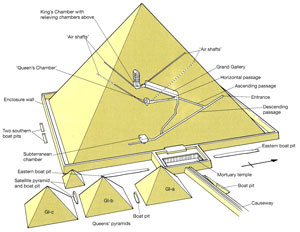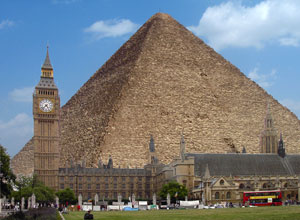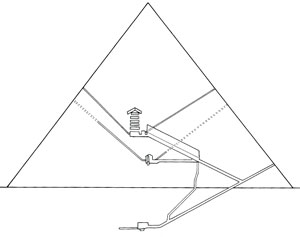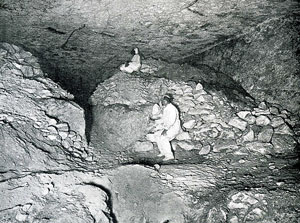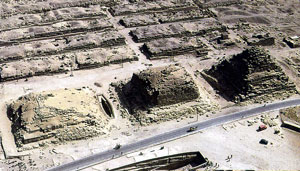
Fact
file: The Great Pyramid
Height: 146m (when first made)
Height: 139m (now - the top is missing)
Built for: Khufu
Name: Akhet Khufu (Horizon of Khufu)
Date: around 2484BC
Width of each edge: 230m
Angle of each face: 51°50'
Volume: 2,583,000 cubic metres
Weight: 5,000,000 tonnes
Number of blocks: 2,300,000
Average weight of each block: 2.5 tonnes
Heaviest blocks: up to 80 tonnes (above the burial chamber).
Number of rows of blocks: 203 (originally about 217)
Pyramid is made of: limestone (mainly), Tura limestone (a better quality stone for the outside of the pyramid), granite (for some parts inside the pyramid), and mortar (a cement made of gypsum).
Time it took to build: experts have different ideas, but one recent estimate is 14 years.
Diagram of the finished pyramid with its temple and queen's pramids
Number of workers needed
During the first year of building: 21,000 workers at Giza (block haulers, stone setters, ramp builders, quarrymen, plasterers, tool makers, water carriers etc.). More were needed to cut better quality stones at other quarries, and to mine the copper used for tools. In later years the number of workers needed was a lot smaller (about 5,000 in the eighth year).
Accuracy facts
The base of the pyramid is level to within 2.1cm.
The sides are aligned to the points of the compass with only a tiny error (1/20 of a degree).
The biggest difference in length between the four sides is 4.4cm (out of 230m!).
The outer stones are so well cut and fitted together you couldn't get a piece of paper between them.
The Great Step - a block of stone just before the burial chamber - is at the height where the area of the pyramid is exactly half the area of the base.
The Great Pyramid
The Great Pyramid of Khufu is the most famous pyramid in the world. It is the only one of the seven wonders of the ancient world which has survived, despite being 2000 years older than all the rest. It is a truly amazing construction. Not only was it the tallest building in the world for 3,800 years (when Lincoln Cathedral took over), it is the most accurately made stone building ever. The precision with which it was made has astounded Egyptologists for centuries, and many have wondered at how it could have been made.
Amazing Construction
The pyramid is absolutely enormous, much taller than Big Ben (see below), and the base of it is a big as eight football pitches! It is made of over 2 million huge limestone blocks. These had to be carefully cut from the bedrock of the desert, dragged up to the pyramid, and set in place. Experts think that one of these 2 tonne blocks was pushed into place every two or three minutes! Each day during the first year, the workers added 3,700 tonnes of rock to the pyramid.
How the Great Pyramid would appear next to Big Ben
And yet the ancient Egyptians had none of our modern machinery. No lorries, no cranes, no electric saws - no electricity at all. They didn't even have iron for their chisels - just copper, which is quite a soft metal. And they didn't even have wheels! And for checking levels and verticals all they had was simple tools like plumb lines. With so little technology, it is amazing the Great Pyramid is so well made. To learn how the pyramids were made, follow this link.
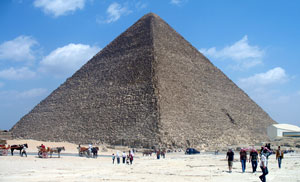
The Great Pyramid. The people and car next to the pyramid give a
sense of how big it is. Click for a larger version.
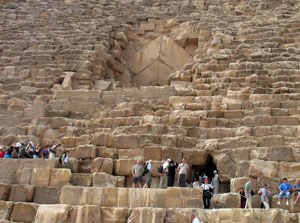
The entrance to the pyramid - the modern entrance for tourists is below, and
the original entrance is above with the huge stones laid at sloping angles.

Close up of the pyramid showing the size of the
blocks. The blocks get smaller the higher you go up the pyramid.
Khufu
The Great Pyramid was built for
the pharaoh Khufu, the second king of the 4th dynasty of Egypt (a dynasty is
a ruling family). The Greeks called him Cheops. His father was Sneferu, who was had the Bent and the Red
Pyramids built, and his sons were Djedefre (the next pharaoh) and Khafre
(who had the big pyramid next to Khufu's).
Khufu's name is written
like this:

From left
to write the letters are Kh - u - f - u. His name is written inside the
Great Pyramid, in chambers above the burial chamber. 'Khufu' is actually
short for 'Khnum-Khufwy' which means 'May Khnum (the god) protect me'. He
was known by the Greeks as 'Cheops' (Kee-ops). He
ruled for 23 years. The only image of him that exists is a 7cm statue:
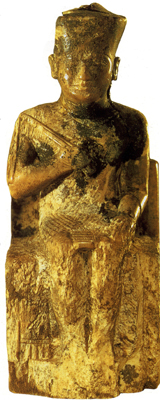

Khufu's cartouche
Great Pyramid from above, showing how it is surrounded by tombs of noblemen
Khufu's sarcophagus

a corner of the Great Pyramid
Inside the Great Pyramid
There are several tunnels and rooms inside the Great Pyramid. The first tunnel, the descending corridor, goes down into the rock underneath the pyramid, and here is the 'Subterranean Chamber'. It is not finished, and no one is sure why it was built. It seems unlikely it was ever meant for the king's burial as the corridor isn't big enough to let down his sarcophagus (his stone coffin). It may represent the Underworld cavern (the realm of the dead).
The Queen's Chamber
Leading up from the descending corridor is the ascending corridor. About half way up it branches - straight ahead a tunnel leads to the 'Queen's Chamber'. It was given this name a long time ago but we now know it wasn't made for a queen. It was originally closed off with stone, and has a niche in the east wall. It may have been a 'serdab', which is a special room for the ka statue of the king. The ka was the life force - a special sort of spirit which was a copy of the king.
The Grand Gallery
The ascending passage opens up into the amazing Grand Gallery - a huge space with corbelled walls (this means that it gets narrower as it goes up). It is nearly 9m high and 46m long.
At the top there is a short and very low passage (you have to stoop to get in). Here there was a space where a portcullis system lowered stone blocks to seal off the burial chamber and keep out thieves (they still broke in!).
The King's Chamber
Then you reach the King's Chamber - the room Khufu was buried in. It is 10m long by 5m wide, nearly 6m high, and lined with huge blocks of red granite. It is empty except for the granite sarcophagus. The corner is broken, probably by thieves trying to get the lid off to rob the king's treasures. It is too big to get in the doorway and so it must have been placed there as the workers built the pyramid.
The Air Shafts
One of the mysteries of the Great Pyramid is the so-called air shafts, small tunnels which lead up from the King's Chamber and the Queen's Chamber, toward the outside of the pyramid. They are only 20cm wide, and are certainly not to bring air into the pyramid. The ones leading to the Queen's Chamber don't even lead into the chamber. A small robot was sent up one of these shafts and came to a stop after 200 feet, faced with a block with two copper pins set into it. The shafts may be symbolic, a way for the king's soul to rise up to the stars. They may also have been building lines, to help the workers build the pyramid accurately.

The Queen's Pyramids
On the east side of Khufu's pyramid were three small pyramids, called queen's pyramids. One of these was for his mother Hetepheres, wife of Sneferu. Some beautiful treasure was found in here, including an alabaster sarcophagus, a bed, chairs, carrying chair, and her canopic chest (containing jars for her organs).
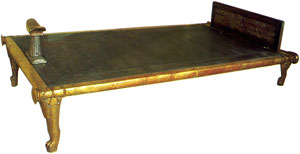

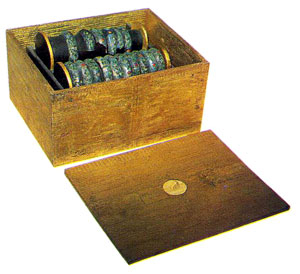


The other two pyramids were for queens Meritetes and Henutsen.

plan of the queens' pyramids, side and above
The Solar Boats
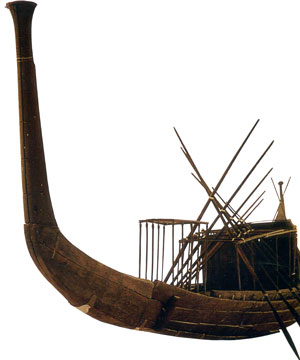
Next to the Great Pyramid five large pits were dug which are boat shaped. These may have had symbolic meaning, as boats to transport the king's soul to the stars. South of the pyramid are two more pits which actually held real boats which had been taken apart. One of these boats, which had 1224 pieces made of cedarwood, was finally put together after years of painstaking work. It is 43m long, and can be seen in a special museum next to the pyramid.
It is thought that these boats were used when Khufu's body was brought to the pyramid for mummification and burial.
